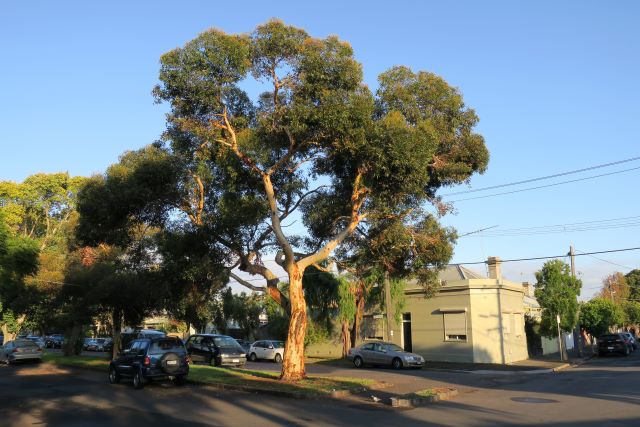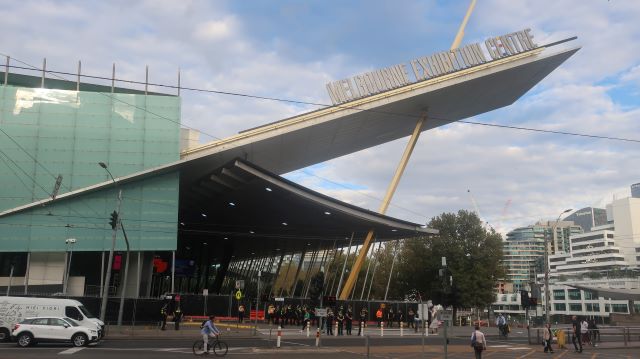Back to the city
I accepted my own invitation and went back to the city to attend the City of Melbourne’s Future Melbourne Committee.
Two items about heritage on the agenda had attracted my attention: the proposed demolition of the Jack Dyer Stand at Punt Rd Oval and the near final step in listing three sites in Fishermans Bend for heritage protection.
These days, of course, when you can watch council meetings online, why would you attend in person?
I was rewarded.
Arriving early, I sat on a bench outside the Town Hall watching guests arrive for the Melbourne Music Week awards. It was like watching the Oscars. Famous people I didn’t recognise in spectacular plumage entered the Town Hall.
The setting for the Future Melbourne committee has greatly improved since I last attended. Instead of gruelling safety and identification processes, toiling up the stairs and down passages to the meeting room, the Committee now meets on the ground floor of the Town Hall, in a line of sight of Swanston St.
People attending the meeting enter under Mandy Nicholson’s ‘Wurundjeri Biik, yalinguth, yalingbu, yirramboi’ (Wurundjeri Country, yesterday, today, tomorrow) tapestry woven at the Australian Tapestry Workshops. Nicholson is a Wurundjeri-willam (Wurundjeri-baluk patriline) artist.
The Lord Mayor. Sally Capp, sat at the centre of a contemporary, curved bench with councillors on either side.
A countdown to the start of the meeting made it feel like a live performance – which it is. The meeting started on the dot of 5.30 pm.
Not being a Richmond fan, I entered the meeting with a detached interest in the demolition of the Jack Dyer Stand which had been reported in the paper earlier in the day. Nevertheless, as a person with a strong interest in heritage, I felt sympathetic to the retention of the Jack Dyer Stand. Submitters called in about the loss of trees and the stand. Arguments were put to Council about the advantages of the new facility: a new ground for AFLW, the ‘quiet’ and understated new stand accommodating training and other facilities. Deputy Lord Mayor Nicholas Reece argued that the MCG had been drastically changed, yet still remained the Peoples Ground. After hearing arguments from Lord Mayor Sally Capp and Cr Rohan Leppert, I was persuaded by their conclusion that the community benefit outweighed the loss of heritage.
Should there have been a dissenting voice among the councillors as Adam Ford suggested, or were they all truly united in supporting the proposal?
The Minister for Planning will make the final decision on this matter.
The next item was the near final step, after a long and rigorous process, towards the heritage protection of three sites in Fishermans Bend: parts of the Kraft Vegemite factory, Shed 21 off Lorimer St, and an electrical substitution off Salmon St on Turner St.
The electrical substation was constructed by the State Electricity Commission in 1935 to provide power to the new General Motors Holden (GMH) factory. The architecture of the substation consciously responded to that of the GMH site opposite. Sir Lawrence Hartnett’s account of the establishment of GMH factory at Fishermans Bend, not surprisingly, puts GMH at the centre of the story. Yes, GMH people built the buildings – the administrative complex and the factory buildings – but the successful operation of the plant relied on infrastructure contributions from a number of other parties.
The statement of significance says “The construction of the 1935 Electricity substation is of historical significance as a successful government catalyst to stimulate manufacturing in Fishermans Bend by the provision of electricity”.
The Melbourne Harbor Trust created the wharves. The SEC provided the power. The MMBW laid a sewer down Salmon St. In the new Fishermans Bend this is referred to as ‘enabling infrastructure’.
In last year’s State Budget, $179 million was allocated to create the roads and other services that will be required for the University of Melbourne campus and the innovation precinct.
The intention is the same as that which motivated the government in the thirties to stimulate economic activity in Fishermans Bend.
It was appropriate that the agenda concluded with an item on the City of Melbourne’s innovation policy which is to assist, stimulate, provoke and support innovation across the City, and in Fishermans Bend.
While the debate about the Jack Dyer Stand was interesting, a chill wind blew over me when I substituted ‘Norm Goss Stand’ in Port Melbourne for ‘Jack Dyer Stand’. Every argument advanced about the Jack Dyer Stand – its lack of compliance with every contemporary safety and acccessibility code, its limited seating capacity and facilities, made me nervous.
I remembered attending Ray Julier’s funeral. Julier was a former Mayor of Port Melbourne and for many years a trainer at the Richmond Football Club. The flowers on his coffin were part Port’s blue and red, and half the Tiger’s brown and yellow.
Dustin Martin was sighted in Port well before this evening’s well publicised return to the game.
It reminded me how much heritage is about associations, stories, attachments and questioning to what extent these are incorporated in the built fabric.
The heritage legacy of 2021 would be the energy transformation in Fishermans Bend to all renewable power.




John
Interesting Janet.